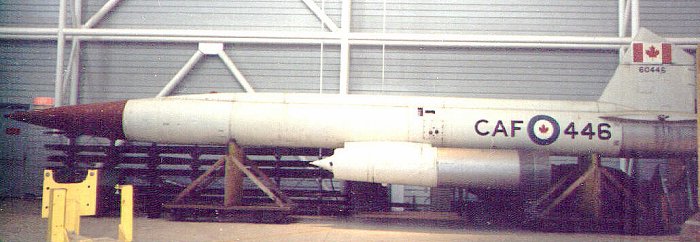
Period: Postwar
Uses: Missile
First Flight: 1959 (MiM-10A)
Display Status: In Storage Area - assembled and accessible.
Introduced after the cancellation of the Avro Arrow, the Bomarc filled an anti-aircraft role as an unmanned long-range, surface-to-air weapon. By 1962 two RCAF Missile Squadrons were equipped with Bomarcs as part of the North American Air Defence Command (NORAD). Both squadrons formally disbanded on April 7, 1972. The Bomarcs were returned to the United States by September of that same year.
The Bomarc was a winged missile stored horizontally in a shelter from which it could be launched, after being raised vertically through a sliding roof. A solid-propellant booster rocket augmented the thrust of the two integral ramjet engines. Bomarc stands for Boeing Michigan Aeronautical Research Center.
The Boeing CIM-10B Bomarc nuclear-armed surface-to-air interceptor missile equipped 446 and 447 Squadrons in North Bay, Ontario and La Macaza, Quebec respectively for North American air defence from 1961 to 1972. 60446 was one of the 26 missiles at RCAF Station/CFB North Bay out of a total of 56 in Canadian service. As stated in 1971 White Paper on Defence: "The BOMARC missiles sited in Canada were a relatively important contribution in the days when a full anti-bomber defence existed to defend urban-industrial targets as well as to protect the deterrent which consisted largely of the US bomber force. The deployment by the USSR of a missile force numbering in the thousands has altered considerably the strategic situation. The Bomarcs have become highly vulnerable to a missile attack since they cannot be dispersed like aircraft. Moreover, the Canadian Bomarcs are sited to defend the eastern part of North America whereas the preponderance of the US land-based strategic retaliatory forces is located in the mid-west. Since no comprehensive defence of population against missile attack is likely to be available in the foreseeable future, the Government has concluded there is no longer sufficient reason to continue to deploy Bomarcs in Canada, and this system will therefore be retired."
Photo Detail
|
Registration Number |
60446 (RCAF) |
|
Manufacturer |
Boeing Airplane Company, USA |
|
Manufacture Date |
1960 |
|
Construction Number |
656 |
|
Acquisition Date |
1972 |
|
Provenance |
Transfer from CAF |
Manufactured in Seattle, Washington, this Bomarc served with the RCAF and the Canadian Armed Forces until 1972 when it was transferred to the Canada Aviation Museum.
Specifications
|
Wing Span |
18 feet 2 inches (5.5 m) |
|
Length |
45 feet 1 inch (13.7 m) |
|
Height |
2 feet 11 inches (0.89 m) |
|
Weight – Empty |
Unknown |
|
Weight – Gross |
16,032 lbs. (7,272 kg) |
|
Cruising Speed |
2,134 mph (3,434 km/h) |
|
Maximum Speed |
2,134 mph (3,434 km/h) |
|
Rate of Climb |
Unknown |
|
Service Ceiling |
100,000 feet (30,480 m) |
|
Range |
440 miles (700 km) |
|
Power Plant |
Two Marquardt RJ43-MA-7, 2,000 LB (5,440 KG), static thrust ramjets, plus one Thiokol XM-51 50,000 LB (22,650 kg) static thrust rocket engine |
| Return to Top of Page |
Updated: February 13, 2001